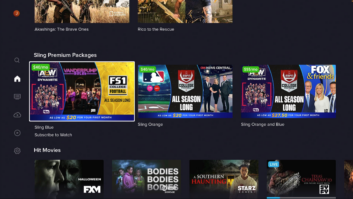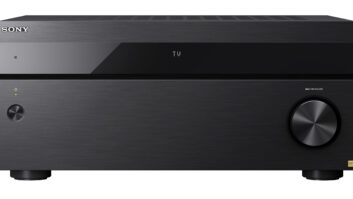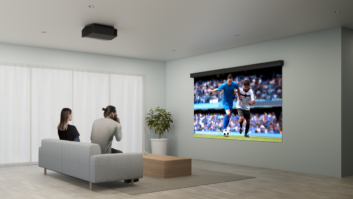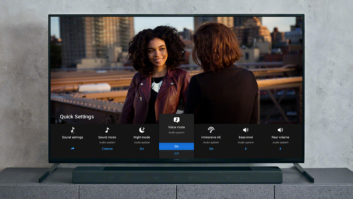September has been a busy month for the CEDIA channel, an perhaps an even busier month for Apple, as evidenced by all of new products announced on Tuesday that will be available for retail availability before the end of the month.
Yes, the general press has been rife with rumors and speculation about the new iPhone 8 and iPhone X models, and, to a lesser degree, a new Apple Watch. Yes, there was some advance news about a new Apple TV, but not as much. For those reasons, we’ll leave the coverage of the first three new products to others, except where there are a few items of interest for the integrator.

We’ve been waiting for Apple TV to catch up to the 4K/UHD competition such as Roku’s Premiere+ and Ultra, Chromecast Ultra and a myriad 4K Android TV products such as the Mi Box. Oh, and sooner than later we’ll most likely see a new 4K Fire TV line and updates from Roku.
However, this is Apple TV’s day, so we should let it have its moment in the sun.
The world of streaming services has progressed enormously since the current “Gen. 4” Apple TV was released just short of two years ago. Yes, the tvOS has been updated to the current 10.2.2 for Gen.4 with the Apple TV app as its core. However, without 4K and HDR, something new was needed. With retail availability on September 22, you’ll soon be able to have it.
Apple TV 4K will, as the name puts forward, offer 4K streaming (no mention of UHD throughout the presentations). Pushing the bar further, it joins the Chromecast Ultra as the only streaming device with Dolby Vision; others such as Roku and Android TV boxes only offer HDR10. To be sure, this is a major card in Apple’s deck, as high dynamic range is as important—some would say more important—to increased video quality as the added resolution. From a standards perspective, the Apple TV 4K also has the HEVC decoding, HDMI 2.0a, and HDCP 2.2 standards under its belt, as the formats require.
For the integrator, the new model poses few challenges. The new unit is the same size as the current model, and the rear panel is virtually identical other than the deletion of the USB-C port for upgrades that was never used and is presumably no longer required for updates. The remote is also the same size and shape, retaining the wireless capability so that no line of sight from the remote to the unit is needed. Hide it away (within range, of course) to your heart’s content.
The internals that power the unit have been updated to the same A10X Fusion processor that powers the current iPad models, and wired connectivity moves up from 10/100 to gigabit Ethernet; 802.11ac remains for Wi-Fi. As with prior Apple TV models, the power supply is built in, so only a standard power cord is needed.
The software and services aspect of the new Apple TV 4K are as important a part of the story as the hardware. As one might expect, there will be 4K content from Apple’s own iTunes service as well as from Netflix now, and Amazon later this year. Even better, iTunes customers with existing purchased content libraries will see them upgraded to 4K at no extra charge. As to new 4K titles, they will be priced identically to HD versions. The net result of this is high resolution content that is likely to be priced below other services. Along with the participating streaming services, 4K content will be available in iTunes from Fox, Lionsgate, Paramount, Sony, Universal, and Warner Bros. Curiously, Disney is not listed as participating in 4K despite the strong ties between Apple and that studio.
Along with native 4K content, the new Apple TV will upscale all content to 4K, though at this juncture it remains to be seen if the scaling is better than what is built into the display. Not having seen the menu structure yet, it is hard to tell if the scaling may be turned off. Also upgraded are the menus and screen savers, both of which will now be 4K, as well.
Key to the total package is Apple’s TV App, first introduced with tvOS in the prior Apple TV model. The new tvOS 11, due concurrently with the 4K product, will add new features such as live news and sports, including reminders about games of interest to the viewer. However, there was no mention of sports in 4K, which for the moment is carried mostly on DirectTV.
Although the physical connectivity has not changed, there is a connectivity-related item that will come with the complete palette of Apple OS updates. With the inclusion of AirPlay 2, you will be able to stream content throughout the Apple/iOS/tvOS ecosystem in an installation. Thus, Apple will enable AirPlay 2-compatible speakers to deliver the same functionality that Alexa, Google, HEOS, Sonos, Play-Fi, and Bluesound and others are already delivering.
Finally, there was more than the usual mention of games for Apple TV, with a full segment devoted to a new game called Sky from thatgamecompany. (Yes, that is their name!) However, there was no mention of any 4K gaming.
When all is said and done, these updates and improvements will undoubtedly once again make Apple a contender in a market segment where it is now running fourth behind Roku, Chromecast, and Amazon Fire TV. Pricing will be $179 for the 32GB model and $199 for the 64GB model. The current Apple TV remains in the line at $149. As noted at the top, consumer preorder is September 15 for retail availability one week later, on September 22.
There were a few other notes of interest from the Apple event for residential specialists. On the phone side, both the new iPhone 8 and iPhone X models will capture video in 4K at 60Hz and HD at 240Hz. The high-end iPhone X, which will start at a $999 price, will also have both HDR10 and Dolby Vision to complement its 2456×1125, 458 DPI, OLED, “Super Retina” display, but not Dolby Vision as is the case with competitive phones and the Apple TV 4K.
One addition to the new phones that will influence both installations and the products you carry is that they will be the first iPhones with wireless charging. In a distinct change from Apple’s tendency to use walled garden, proprietary technologies such as the old 30-pin connector and the newer Lightening connector, Apple has selected the open Qi standard. This means that third-party accessory companies, including Belkin, Mophie, iHome, Aircharge, and others will be ready at launch with Qi chargers that have already been certified. For office, family room, and bedroom situations, wireless charging will be something to integrate and eliminate wire clutter on the client’s tables and other furniture. Anyone carrying the phones or anticipating them in an installation would be wise to add one or more of these lines to their card.
Apple also showed a “sneak peek” at a future product idea for a first-party Qi charger that will be of interest for all Apple family installations if and when it appears. AirPower is a rounded edge, rectangular-sized mat that one can charge an iPhone, Apple Watch, and AirPods at the same time and have them all charge with an app on the phone showing the charge status. Look for AirPower sometime next year.
One thing to always look for at these introductions are what was not mentioned. Along with no mention or availability of Disney titles in 4K/UHD, there was no mention of HomePod. Still scheduled for this year, for December, there was no additional information about its place in the expanded tvOS and iOS ecosystems. Also, as expected, but still worth noting, while there was considerable attention paid to the AR functionality of the new iPhones—it appears that AR, rather than the VR features for Android, is Apple’s direction.







